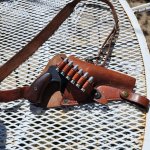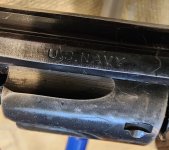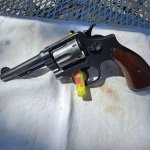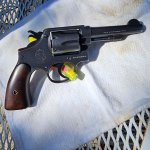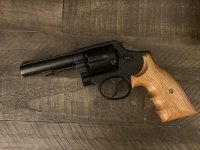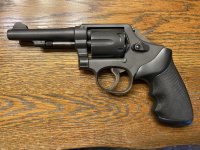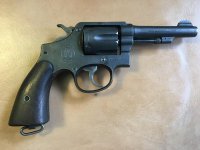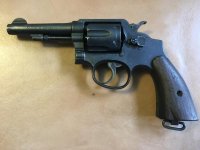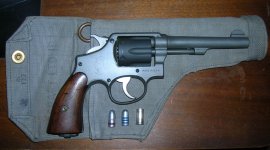You are using an out of date browser. It may not display this or other websites correctly.
You should upgrade or use an alternative browser.
You should upgrade or use an alternative browser.
Victory Model reparkerizing--Recommendation?
- Thread starter MelvinWalker
- Start date
Years ago I got a Victory model from the National Guard armory for 75$.(1980s) It was solid but the finish was worn. I wanted to reparkerize it but the shop all but insisted I should get it blued. So I ended up with a matte blue which was inauthentic. Years(90's) later I got a well worn British Victory model for 60$ from a wholesaler. It was stuck due to the extractor rod loosening and had a well worn black paint finish over a worn parkerized. Cylinder and sideplate were swapped at some point based on numbers. Probably from India or Pakistan. It sat in a safe for 15 years as-is. Finally I decided to make it work and by then I was into DIY stove-top parkerizing. The only parts I replaced were a cylinder stop and the beat wood grips. I disassembled it and snuck the parts into work to bead blast them, not sandblast. I used Manganese phosphate and the cylinder came out almost black for some reason but the rest looked normal. Now it is a perfectly good shooter, with shiny bore and cylinder play is not bad. If you have a way to bead blast gun steel or other ways to remove all old finish and rust, you can do it yourself on the cheap. It is really a pretty easy process if you read the instructions. I have done various guns and gun parts myself. For the cost of the chemical kits.
Last edited:
Years ago I got a Victory model from the National Guard armory for 75$.(1980s) It was solid but the finish was worn. I wanted to reparkerize it but the shop all but insisted I should get it blued. So I ended up with a matte blue which was inauthentic. Years(90's) later I got a well worn British Victory model for 60$ from a wholesaler. It was stuck due to the extractor rod loosening and had a well worn black paint finish over a worn parkerized. Cylinder and sideplate were swapped at some point based on numbers. Probably from India or Pakistan. It sat in a safe for 15 years as-is. Finally I decided to make it work and by then I was into DIY stove-top parkerizing. The only parts I replaced were a cylinder stop and the beat wood grips. I disassembled it and snuck the parts into work to bead blast them, not sandblast. I used Manganese phosphate and the cylinder came out almost black for some reason but the rest looked normal. Now it is a perfectly good shooter, with shiny bore and cylinder play is not bad. If you have a way to bead blast gun steel or other ways to remove all old finish and rust, you can do it yourself on the cheap. It is really a pretty easy process if you read the instructions. I have done various guns and gun parts myself. For the cost of the chemical kits.
I appreciate it...I was going to try soda blast because of the fine grit of the baking soda and it won't remove any markings. I already bought a soda blaster kit from Amazon and the manganese phosphate. I just need a good day of patience, disassembly and more patience.
re- park.............
good information what Tom said above and what we used to do many years ago, when we had the shop.......... if you can access either 'Zinc phosphate ( that was used to get the gray or even greenish finish , but to get the green,one had to slow cook the parts in 'cosmoline' for a while turned the gun 'green": looked like it was in "storage" ( yes there were shops out there who used to cheat many of these guns back years ago, had to be careful just who you bought off of then, caveat emptor),,,as for the black, either 'black oxide" over a bead blasted finish, but that is a bluing, that is actually 'black' (no niters in the solution), the black in parkerizing is like Tom said above "manganese phosphate" what the military did like on the M-16s and stuff.....and yes it easy enough to do , my wife actually did an old Colt Detective special ,taken all apart and she did it on the kitchen stove just to proove it could be done and yes ,by a girl........
good information what Tom said above and what we used to do many years ago, when we had the shop.......... if you can access either 'Zinc phosphate ( that was used to get the gray or even greenish finish , but to get the green,one had to slow cook the parts in 'cosmoline' for a while turned the gun 'green": looked like it was in "storage" ( yes there were shops out there who used to cheat many of these guns back years ago, had to be careful just who you bought off of then, caveat emptor),,,as for the black, either 'black oxide" over a bead blasted finish, but that is a bluing, that is actually 'black' (no niters in the solution), the black in parkerizing is like Tom said above "manganese phosphate" what the military did like on the M-16s and stuff.....and yes it easy enough to do , my wife actually did an old Colt Detective special ,taken all apart and she did it on the kitchen stove just to proove it could be done and yes ,by a girl........
My buddy bought a bead blast cabinet at Harbor Freight (I believe around $100) and has done some great work for me. One was this finished challenged ex police model 10 HB which he bead blasted and then had the gunsmith I bought it from reblue it. Came out a beautiful matte blue similar to a model 28. It’s perfect to me.
Another finish challenged blued model 10 was bead blasted then home parkerized by another friend.
My victory is a rough finish I would say is more towards grey than black but I think it’s original.
Another finish challenged blued model 10 was bead blasted then home parkerized by another friend.
My victory is a rough finish I would say is more towards grey than black but I think it’s original.
Attachments
- Joined
- Sep 16, 2023
- Messages
- 705
- Reaction score
- 1,353
I’ve used these guys for Ceracoating. They offer Parkerizing. (They do refer to it as “almost black.”). It’s your revolver, so do as you please. I’ve been pleased with this shop’s services.
Services - Oakridge Custom Finishing, LLC
Services - Oakridge Custom Finishing, LLC
This is the British Victory that I refinished with stove top phosphate. Like I said I have no idea why the cylinder turned out about blackish, and darker. Brownells sells a chemical that you can dip your steel parts in before you parkerize that is intended to make them come out black, but I did not use that this time. I let the chambers be phosphated but I used tight rubber stoppers to not bead blast the barrel bore and also left them in to not phosphate the nice shiny bore. Some insisted to me that the almost boiling hot phospate solution would cause the stoppers to pop out of the barrel but that did not happen. I use a big glass thermometer to keep my solution heated within the ideal range, well below boiling point. It is important that you rinse the parts well in hot water to neutralize the chemical reaction and I have a can of neutralizer to spray on which is an oily stuff sort of like WD-40 maybe. The hot water evaporates and the spray penetrates and also displaces any trapped moisture. I don't care for the zinc type solution becuase I always got a really light pale gray color compared to manganese.
Attachments
This is the British Victory that I refinished with stove top phosphate. Like I said I have no idea why the cylinder turned out about blackish, and darker. Brownells sells a chemical that you can dip your steel parts in before you parkerize that is intended to make them come out black, but I did not use that this time. I let the chambers be phosphated but I used tight rubber stoppers to not bead blast the barrel bore and also left them in to not phosphate the nice shiny bore. Some insisted to me that the almost boiling hot phospate solution would cause the stoppers to pop out of the barrel but that did not happen. I use a big glass thermometer to keep my solution heated within the ideal range, well below boiling point. It is important that you rinse the parts well in hot water to neutralize the chemical reaction and I have a can of neutralizer to spray on which is an oily stuff sort of like WD-40 maybe. The hot water evaporates and the spray penetrates and also displaces any trapped moisture. I don't care for the zinc type solution becuase I always got a really light pale gray color compared to manganese.
I wish you were closer to me....I'd buy you a beer and employ your services. That looks really good to me. I have seen original finishes on these Victories that sometimes exhibit that same effect of darker cylinder. It must be something about the metallurgy makeup differences between the two.
Did you completely disassemble the gun all the way down to the bare frame before parkerizing or did you leave some things attached? I see that your hammer and trigger look correct because they have the right case hardened look versus the phosphate frame, etc.
REALLY good job on that.
I have never taken on the task of working on other people's guns for liability reasons. However I also do no longer have access to a bead blast cabinet like I did when I was working. Although I know a gunsmith who might do it or let me. I Stripped the gun down to bare barrel and frame and beaded to bare steel. Then you got to do the process before any rust can start as there can be no oil or dirt or fingerprints on the metal. I smuggled it in parts at a time, as bringing major gun parts in might cause a tizzy so I worked after hours. The hammer and trigger case is pretty much visibly gone from this one. It was rode hard during the war and after. But it had no rust or pitting. I also parkerized a Chinese Tokarev, a 1910 Mauser .25 beater, and mil surp parts for my restorations over the years. I suppose stripped to shiny bare steel can be parkerized, no need to blast, just clean and contamination free.
DWalt
Member
The commercial Parkerizing (phosphate) finishing procedure includes a final dipping of the phosphated part into a solution of sodium dichromate. That is a rust inhibitor. A phosphate finish is an excellent foundation for the application of a spray and bake black Teflon finish. I have done that on many guns. It is nearly indestructible and also looks good. Probably the highest durability gun finish that can be easily performed.
Last edited:
Similar threads
- Replies
- 5
- Views
- 407
- Locked
- Replies
- 9
- Views
- 2K
- Replies
- 4
- Views
- 2K
- Replies
- 55
- Views
- 5K

